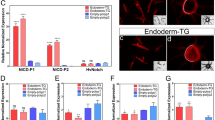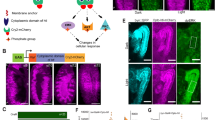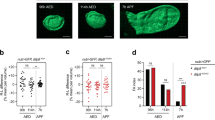Abstract
Unlike the trunk segments, the anterior head segments of Drosophila are formed in the absence of pair-rule1,2 and HOX-cluster gene3 expression, by the activities of the gap-like genes orthodenticle (otd), empty spiracles (ems) and buttonhead (btd)4,5. The products of these genes are transcription factors6,7, but only EMS has a HOX-like homeodomain8,9. Indeed, ems can confer identity to trunk segments10 when other HOX-cluster gene activities are absent3,11. In trunk segments of wild-type embryos, however, ems activity is prevented by phenotypic suppression10, in which more posterior HOX-cluster genes inactivate the more anterior without affecting transcription or translation12. ems is suppressed by all other Hox-cluster genes and so is placed at the bottom of their hierarchy10. Here we show that misexpression of EMS in the head transforms segment identity in a btd-dependent manner, that misexpression of BTD in the trunk causes ems-dependent structures to develop, and that EMS and BTD interact in vitro. The data indicate that this interaction may allow ems to escape from the bottom of the HOX-cluster gene hierarchy and cause a dominant switch of homeotic prevalence in the anterior–posterior direction.
This is a preview of subscription content, access via your institution
Access options
Subscribe to this journal
Receive 51 print issues and online access
$199.00 per year
only $3.90 per issue
Buy this article
- Purchase on Springer Link
- Instant access to full article PDF
Prices may be subject to local taxes which are calculated during checkout




Similar content being viewed by others
References
Pankratz, M. & Jäckle, H. in The Development of Drosophila melanogaster (eds Bate, M. & Martinez Arias, A.) 467– 516 (Cold Spring Harbor Laboratory Press, Cold Spring Harbor, 1993).
Martinez Arias, A. in The Development of Drosophila melanogaster (eds Bate, M. & Martinez Arias, A.) 517–608 (Cold Spring Harbor Laboratory Press, Cold Spring Harbor, 1993).
Manak, J. R. & Scott, M. P. A class act: conservation of homeodomain protein functions. Dev. Suppl. 61– 77 (1994).
Jürgens, G. & Hartenstein, V. in The Development of Drosophila melanogaster (eds Bate, M. & Martinez Arias, A.) 687–746 (Cold Spring Harbor Laboratory Press, Cold Spring Harbor, 1993).
Cohen, S. M. & Jürgens, G. Mediation of Drosophila head development by gap-like segmentation genes. Nature 346, 482–485 (1990).
Finkelstein, R., Smouse, D., Capaci, T. M., Spradling, A. C. & Perrimon, N. The orthodenticle gene encodes a novel homeo domain protein involved in the development of the Drosophila nervous system and ocellar visual structures. Genes Dev. 4, 1516–1527 (1990).
Wimmer, E. A., Jäckle, H., Pfeifle, C. & Cohen, S. M. A Drosophila homologue of human Sp1 is a head-specific segmentation gene. Nature 366, 690–694 (1993).
Dalton, D., Chadwick, R. & McGinnis, W. Expression and embryonic function of empty spiracles: a Drosophila homeo box gene with two patterning functions on the anterior-posterior axis of the embryo. Genes Dev. 3, 1940–1956 (1989).
Walldorf, U. & Gehring, W. J. Empty spiracles, a gap gene containing a homeobox involved in Drosophila head development. EMBO J. 11, 2247–2259 (1992).
Macías, A. & Morata, G. Functional hierarchy and phenotypic suppression among Drosophila homeotic genes: the labial and empty spiracles genes. EMBO J. 15, 334–343 (1996).
Lewis, E. B. A gene complex controlling segmentation in Drosophila. Nature 276, 565–570 ( 1978).
Duboule, D. & Morata, G. Colinearity and functional hierarchy among genes of the homeotic complexes. Trends Genet. 10, 358–364 (1994).
Wimmer, E. A., Cohen, S. M., Jäckle, H. & Desplan, C. buttonhead does not contribute to a combinatorial code proposed for Drosophila head development. Development 124, 1509–1517 (1997).
Gallitano-Mendel, A. & Finkelstein, R. Ectopic orthodenticle expression alters segment polarity gene expression but not head segment identity in the Drosophila embryo. Dev. Biol. 199, 125–137 ( 1998).
Janody, F., Reischl, J. & Dostatni, N. Persistence of Hunchback in the terminal region of the Drosophila blastoderm embryo impairs anterior development. Development 127, 1573–1582 (2000).
Schöck, F., Sauer, F., Jäckle, H. & Purnell, B. A. Drosophila head segmentation factor Buttonhead interacts with the same TATA box-binding protein-associated factors and in vivo DNA targets as human Sp1 but executes a different biological program. Proc. Natl Acad. Sci. USA 96, 5061–5065 (1999).
Sadowski, I., Ma, J., Triezenberg, S. & Ptashne, M. GAL4-VP16 is an unusually potent transcriptional activator. Nature 335, 563–564 (1988).
Jones, B. & McGinnis, W. The regulation of empty spiracles by Abdominal-B mediates an abdominal segment identity function. Genes Dev. 7, 229– 240 (1993).
Wimmer, E. A., Frommer, G., Purnell, B. A. & Jäckle, H. buttonhead and D-Sp1: a novel Drosophila gene pair. Mech. Dev. 59, 53–62 ( 1996).
Thummel, C. S. & Pirotta, V. New pCaSpeR P-element vectors. Drosoph. Inf. Serv. 71, 150 (1992).
Rubin, G. M. & Spradling, A. C. Genetic transformation of Drosophila with transposable element vectors. Science 218, 348–353 (1982).
Patel, N. H. et al. Expression of engrailed proteins in arthropods, annelids, and chordates. Cell 58, 955– 968 (1989).
White, R. A. H. & Wilcox, M. Protein products of the Bithorax complex in Drosophila. Cell 39, 163–171 (1984).
Zipursky, S. L., Venkatesh, T. R., Teplow, D. B. & Benzer, S. Neuronal development in the Drosophila retina: monoclonal antibodies as molecular probes. Cell 36, 15– 26 (1984).
Sauer, F., Hansen, S. K. & Tjian, R. Multiple TAFIIs directing synergistic activation of transcription. Science 270, 1783– 1788 (1995).
Schmidt-Ott, U., González-Gaitán, M., Jäckle, H. & Technau, G. M. Number, identity, and sequence of the Drosophila head segments as revealed by neural elements and their deletion patterns in mutants. Proc. Natl Acad. Sci. USA 91, 8363 –8367 (1994).
Rogers, B. T. & Kaufman, T. C. Structure of the insect head as revealed by the EN protein pattern in developing embryos. Development 122, 3419–3432 ( 1996).
Acknowledgements
We thank G. Dowe for sequencing; M. González-Gaitán, G. Vorbrüggen and R. Rivera-Pomar for discussions; C. Klämbt for the 22C10 antibody; and F. Janody and N. Dostatni for the maternal Gal4 driver. The work was supported by the Human Frontier Science Organization (H.J.) and by fellowships of the Fonds der Chemischen Industrie (F.S.), the Alexander-von-Humboldt Stiftung (B.A.P.) and the Boehringer Ingelheim Fonds (J.R.).
Author information
Authors and Affiliations
Corresponding author
Rights and permissions
About this article
Cite this article
Schöck, F., Reischl, J., Wimmer, E. et al. Phenotypic suppression of empty spiracles is prevented by buttonhead. Nature 405, 351–354 (2000). https://doi.org/10.1038/35012620
Received:
Accepted:
Issue Date:
DOI: https://doi.org/10.1038/35012620
This article is cited by
-
Candidate gene screen for potential interaction partners and regulatory targets of the Hox gene labial in the spider Parasteatoda tepidariorum
Development Genes and Evolution (2020)
-
Tc-knirps plays different roles in the specification of antennal and mandibular parasegment boundaries and is regulated by a pair-rule gene in the beetle Tribolium castaneum
BMC Developmental Biology (2013)
-
Mutual regulation of the Drosophila disconnected (disco) and Distal-less (Dll) genes contributes to proximal-distal patterning of antenna and leg
Cell and Tissue Research (2009)
-
Genetic interplay between the transcription factors Sp8 and Emx2 in the patterning of the forebrain
Neural Development (2007)
-
Sp8 exhibits reciprocal induction with Fgf8 but has an opposing effect on anterior-posterior cortical area patterning
Neural Development (2007)
Comments
By submitting a comment you agree to abide by our Terms and Community Guidelines. If you find something abusive or that does not comply with our terms or guidelines please flag it as inappropriate.



